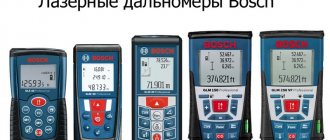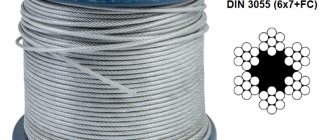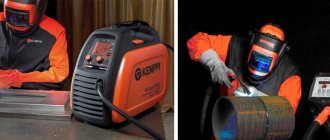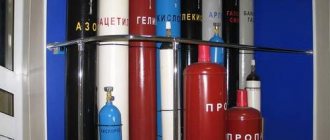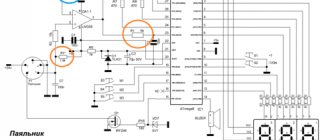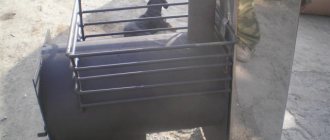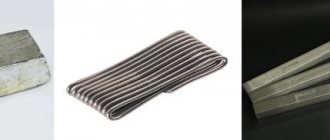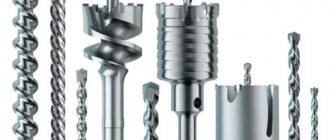A laser rangefinder (or laser tape measure) is a device without which it is difficult to imagine many modern fields of activity. The principle of how a laser rangefinder works is simple, but it makes measuring distances much easier, and does so with high accuracy. Let's discuss how the device works, what characteristics you should pay attention to when choosing for home or professional use.
Laser devices make measurements easier Source campingmanitoulin.com
Types of rangefinders
Based on the principle of operation, laser rangefinders are divided into phase and pulse.
Phase meters
Phase rangefinders do not have a very long range, but they are much more accurate due to the principle of their operation and are cheaper due to the fact that they do not have an expensive, ultra-precise timer built into them.
The phase rangefinder works at short distances, but has good accuracy and a low price
The operating principle of rangefinders of this type is that a laser wave is sent to an object with one phase, and when reflected, returns with another. Having calculated the phase shift, the device determines the distance to the object. Thanks to this operating principle, phase rangefinder measurements are highly accurate. If it is necessary to work at distances exceeding the emitted wavelength, the device sends a signal several times, changing the modulation frequency. The device's processor then determines the exact distance to the target by solving a system of linear equations.
Pulse meters
A pulse rangefinder consists of a radiation detector and a pulsed laser. It calculates the distance to an object by multiplying the travel time of the beam by the speed of light. Pulse meters operate over much greater distances than phase meters due to the higher power of the emitted pulse. Such rangefinders are often used for military sights.
The device of a compact laser construction rangefinder
Despite its apparent simplicity, a laser ruler is a complex engineering device. The laser rangefinder device consists of the following components:
Scheme of laser rangefinder operation
- Emitter - it generates a beam and sends it to the desired point.
- Reflector - it is necessary to receive the beam reflected from the object.
- Microprocessor to perform the necessary calculations.
- A pre-installed program necessary for processing the data obtained during measurements.
- A sight that allows you to direct the beam to the desired location.
- A level with which the device can be strictly aligned in a horizontal or vertical plane.
Additional functions
The microelectronics used in laser rangefinders allows not only direct measurements. Many devices of this type have some additional functions, which include:
- Continuous measurement function. When operating in normal mode, the rangefinder, when you press a button on the remote control, records the result and displays it on the monitor. But quite often, there is a need to constantly measure the distance, for example, from a wall to a future partition. To do this, the device is switched to continuous measurement mode. In this mode of operation, the device independently takes measurements at a certain frequency and displays their results on the monitor. The measurement takes place in real time.
- Determination of the greatest and smallest distance. This function is useful when determining the diagonal in a room. The fact is that it is not so easy to measure it and you can simply miss when directing the laser beam and, as a result, inaccurate results will be obtained. After setting the minimum distance on the device, it will record only those measurements that are greater than the set one.
Terms of use
When working with such devices, certain rules must be followed. Thus, it is strictly unacceptable to direct the laser beam towards a person. Getting it into the eyes can lead to irreparable consequences, including loss of vision.
Taking measurements in bright sunlight can be difficult because the laser marker may be difficult to see. In this case, it is necessary to use special glasses through which it will be immediately visible.
Laser photography on location
When taking measurements outdoors, especially over long distances, it is necessary to use a plate called a visor.
Types of rangefinders
Based on the principle of operation, laser rangefinders are divided into phase and pulse.
Phase meters
Phase rangefinders do not have a very long range, but they are much more accurate due to the principle of their operation and are cheaper due to the fact that they do not have an expensive, ultra-precise timer built into them.
The phase rangefinder works at short distances, but has good accuracy and a low price
The operating principle of rangefinders of this type is that a laser wave is sent to an object with one phase, and when reflected, returns with another. Having calculated the phase shift, the device determines the distance to the object. Thanks to this operating principle, phase rangefinder measurements are highly accurate. If it is necessary to work at distances exceeding the emitted wavelength, the device sends a signal several times, changing the modulation frequency. The device's processor then determines the exact distance to the target by solving a system of linear equations.
Pulse meters
A pulse rangefinder consists of a radiation detector and a pulsed laser. It calculates the distance to an object by multiplying the travel time of the beam by the speed of light. Pulse meters operate over much greater distances than phase meters due to the higher power of the emitted pulse. Such rangefinders are often used for military sights.
Comparison of the operating principles of pulse and phase meters
- A phase rangefinder uses a modulated light signal to measure distance, while a pulse rangefinder uses a light pulse.
- Pulse rangefinders measure much longer distances than phase ones, since the power of the pulses they send is much greater.
- The pulse distance measurement method is less accurate than the phase difference method. But thanks to modern signal processing techniques in pulse rangefinders, this difference becomes less significant.
- The size of the reflected laser dot becomes larger with increasing distance. This is true for both measurement principles, although the deviation of the laser from the reflection point is different because the size and shape of the laser spot is different.
- The phase and pulse principles of operation also differ in sensitivity to signal interruption. When operating under the influence of certain external factors (in traffic, in bad weather conditions), a phase rangefinder will perform worse than a pulse rangefinder.
How to choose a rangefinder: recommendations
Electro-optical rangefinder.
Before purchasing a rangefinder device, you need to decide on the upcoming work, that is, for what purpose it is needed. The more functions a device has, the more it will cost.
Points to consider before choosing:
- Classification.
Similar devices are:
- household;
- professional.
If the device is purchased for interior decoration of apartments, then a simple household device will be suitable for these purposes. If you have to work under more severe conditions and on complex construction sites, then you need to think about professional equipment. But the price of professional devices is much higher. It also happens that some household rangefinders may be equipped with additional functions.
- Measuring range.
Block diagram of a pulse laser rangefinder.
Modern laser measuring instruments can have a beam range of up to 200 m
When purchasing devices with a maximum measurement range, you need to pay attention to the device for installing a tripod, since when taking measurements at long distances, you need to have a tripod. If the device is used for the construction of a country house or on small construction sites, it is enough to use a rangefinder with a range of up to 50 m
- Rangefinder accuracy.
Basically, all laser rangefinders have measurement accuracy with an error of 1.5 to 2 mm, which solves problems in domestic and professional settings.
- Manufacturer.
The quality of rangefinders also directly depends on the manufacturer. The best companies producing rangefinders are considered to be BOSH and Stabila. As a rule, devices from European manufacturers are much more expensive than Chinese-made products, but the quality of Chinese ones is much inferior.
- Warranty service.
Any well-known company provides a warranty card for its equipment, granting the right to service. In normal cases, the warranty is given for 1-2 years for household laser devices and up to 3 years for professional equipment. When purchasing a rangefinder, you need to find out whether there is a center for servicing the equipment of a particular company.
- Design and ease of use.
When selecting a laser device, you need to hold it in your hands. It should be comfortable, light and not fall out of your hands. The smaller the dimensions of the device, the more convenient it is to use, since it can even be placed in a pocket. For ease of use of the rangefinder, many manufacturers equip its body with rubber parts.
- Functionality.
What you need to know about measurement error
The accuracy shows how accurate the instrument's readings are. Compared to ultrasonic models (with an error of 3-6 mm), laser analogues demonstrate better performance. It is important to know the following facts about measurement error:
- Accuracy (error) is indicated in two ways: +/- 0.5% or +/- 1 mm.
- The average error of household devices does not exceed 5-6 mm.
- Professional and semi-professional rangefinders have an error of 1-2 mm.
- There are highly specialized models for which high accuracy is not needed. For example, the error of hunting models can reach 1 m.
There is a concept of a reference point. Most models determine the distance starting from the rear end of the rangefinder. This system is convenient if you work indoors and measure the distance, for example, from wall to wall.
Some tools have multiple reference points, which expands their application possibilities. For example, if the reference point is the front end, this simplifies measurements on the external surfaces of the structure. When working with a tripod, the reference point becomes the tripod attachment point.
Choosing a reference point simplifies work in hard-to-reach places Source ivd.ru
Examples of models from different manufacturers
For home use, you should not buy overly advanced laser measuring tapes. How to choose a decent tool without spending extra money can be seen using the most popular models as an example:
- Bosch DLE has several modifications with similar characteristics. The distance to the object is a maximum of 40 meters. The error is 1.5 millimeters and the temperature range is from -10 to + 50 degrees. They have no additional functions and are not bad for home use. The lack of backlight limits the device's capabilities to bright rooms.
- The Leica DISTO D2 operates at a range of up to 100 meters and has additional functions. It can transmit data via Bluetooth, is small in size and is powered by two batteries. The measurement accuracy is 1.5 millimeters. All this is placed in a shockproof and dustproof case. The disadvantage is the price and work exclusively with iOS.
- MAKITA LD 060P is quite popular among buyers. It has good functionality and an affordable price. The advantages include a large screen and large symbols on it. The technical characteristics do not stand out in any way, but recently defective products have come across.
- Agatec Agatape is suitable even for small construction sites. Range up to 60 meters; additional functions include a stopwatch.
Briefly about the main thing
Laser rangefinders are useful in solving a variety of application problems. The choice of a suitable model is made taking into account the scope and frequency of its use. This will determine which tool with what characteristics will be the best option.
The main characteristics of the device are range and measurement error. They are determined by the laser power; According to this parameter, laser devices are divided into three classes. Additional features may be useful for various purposes: number of reference points, ability to save results, tilt sensor, display backlight. The capabilities of standard household tools are sufficient for use indoors and on small plots of land.
Additional functions and capabilities of laser roulettes
The main functions of laser tape measures are to calculate distances and sizes, angles and hypotenuses, as well as the area and volume of measured objects. All this can be immediately calculated directly on the device display, without making calculations on a calculator. And due to the fact that the device has a built-in memory, you can save calculations in it (the number of stored readings may differ in different models). In addition to various calculations, rangefinders can have the following additional functions and components:
- Auto power off. The function will automatically turn off the device if it is in standby mode for a long time, that is, it is not used. The shutdown time varies between models, so you should check the specific numbers directly with the device manufacturer.
- Holder or tripod. The first structural element is necessary to secure the device to a wall, window sill, table and other objects. If you do mostly indoor work, then you will need a holder. A tripod or tripod is convenient for outdoor measurements. Leica Disto S910 Pro Pack is an example of a laser tape measure with a complete set including holder and tripod. This professional, expensive device is definitely not suitable for everyone, but it has a full range of functions and components that are needed for measurements, both in rooms and in open areas.
Bluetooth. A device with Bluetooth function can connect to a smartphone or tablet and transmit readings to it. Thanks to this, you can save all calculations in the phone’s memory, for example, in a created estimate. Of the good devices for the home with excellent accuracy and Bluetooth, we can recommend the SNDWAY SW-S50.
ADA Cosmo MINI A00410 - laser tape measure
This is a compact device that has a minimum number of functions, but they are quite sufficient for measurements and calculations.
It is an excellent alternative to a regular tape measure and is suitable for finishing and carpentry work, and when installing windows. This is a compact and lightweight device that can be used both on a construction site and at home.
Peculiarities
When working with a laser rangefinder, it is advisable to take into account some features of working with this device.
Rangefinders have the ability to take measurements at different distances and with a certain error. Thus, the maximum distance can range from 60 to 200 meters, with an error of 5 cm. These data are indicated in the product passport. Most rangefinder models operate within the range from – 10 to + 50 degrees.
When operating the device outdoors, you must remember that weather conditions play an important role. Performance may be reduced in both poor and sunny weather.
When taking measurements, it is necessary to eliminate obstacles that may arise between the device and the object, this could be foliage, glass, etc.
The practice of using laser measuring instruments has led to the emergence of certain operating rules. For example, the measurement result will be distorted if the beam is directed at a highly reflective surface (mirror, foil). The result will not be entirely correct if the beam is directed at an object with low reflectivity (tar paper).
To obtain extremely accurate results, use a special device with a reflective surface.
During operation, it is necessary to constantly monitor the condition of the batteries. Weak current sources also negatively affect measurement results.
It is advisable to use a tripod when taking measurements. In this case, the measurement accuracy will be increased.
How to use a laser tape measure
Using a laser rangefinder in practice is a fairly simple task. To perform a measurement, it is enough to set it at the starting point, point it at the object to which it is necessary to measure and activate the device. It must be remembered that to increase accuracy it is advisable to use a tripod, this is especially true when measuring large quantities.
How to use a laser tape measure
That is, measurements can be carried out, perhaps even by one person without the involvement of assistants.
Comparison table of the best laser rangefinders
| Name | Main characteristics | Price |
| Sndway | The operating distance is 40 meters, the error is no more than 2 mm, it can store up to 30 different values in memory, there is a function for calculating height using the Pythagorean formula. | ₽ 1864 Buy |
| Leica | Withstands temperatures down to -25°C., operating distance is 40 meters, error is 2 mm, the device works with Bluetooth and mobile OS. | ₽ 6990Buy |
| BOSCH | There is a color display IPS display, operates at a distance of 120 meters with an error of 1.5 mm and 0.2° when measuring angles, connects via Bluetooth or USB, is protected from dust and splashes according to the IP54 standard. | ₽ 15183 Buy |
| Elitech | The measuring distance is 40 meters with an error of 2 mm, measures angles up to 60°, and has a monochrome display. | ₽ 2213 Buy |
| Makita | The operating distance is 80 meters, it measures the depth and volume of an object in real time using the Pythagorean formula, there is a cover that protects the body of the IP54 standard. | ₽ 11710Buy |
Varieties and their applications
The question of how to choose a laser rangefinder is of interest to people who are faced with the variety of offers for the first time. You can cut off a significant part of them if you formulate the boundaries of use for yourself. According to this principle, laser roulettes are divided into two types:
- Household. The models are relatively cheap, but this does not affect the accuracy. They will help during renovations or construction. Additionally, they are equipped with a calculator for calculating the area, and a small memory for saving measurement results.
- Professional. Such instruments have an expanded range of functions, the ability to measure long distances (50-100 m or more), expanded memory, a high degree of protection from dust and moisture, and work with Bluetooth for data transfer. Many models are threaded and can be mounted on a tripod, increasing measurement accuracy.
Rangefinders have become indispensable assistants in various fields of activity; they are used in the following areas:
- Excavation work during construction and laying communications.
- Construction and finishing work, including marking of lumber.
Many models will help you calculate the amount of materials Source pirometr.com.ua
- Geodetic work, land surveying.
- Installation work during the construction of structures and communications.
- Design of premises and landscape, development of cabinet furniture.
- Applied tasks: hunting, navigation, control (inspection work), military affairs.
To solve design or land management problems, you need tools with a different set of parameters, and it is important to understand which of them are basic and which are secondary.
See also: Catalog of companies that specialize in the reconstruction and rebuilding of houses
Operating principles of laser rangefinders.
According to the method of using the properties of the laser beam, devices are divided into pulse and phase.
The pulse rangefinder device is based on measuring the time it takes for a laser beam to travel from the laser generator to the reflector (object) and back.
Pulse laser rangefinders have high power, range of use, secrecy due to short-term use and imperceptibility, for the human eye, of a beam operating in the infrared range.
All these excellent qualities, just in time, meet the needs and demands of military artillerymen, aviation, navy, etc.
Phase laser rangefinders calculate the distance to an object based on the phase shift of the modulated backlight frequency. As unnecessary, they do not have a reflected signal timer, which makes them low in cost.
The range of use of phase laser rangefinders is small (up to a kilometer), so their area of application is domestic needs and rangefinders for small arms.
Set of laser rangefinder functions
Laser rangefinder KRAFTOOL Laserkraft, 34760_z01 With all the variety of choice of laser rangefinders, simple and inexpensive models have approximately the same capabilities:
- addition, subtraction;
- calculation of area and volume;
- simple Pythagoras;
- frontal reference point;
- starting point from the base;
- built-in protractor;
- folding bracket (for measurements in hard-to-reach places).
More expensive models have wider professional functionality:
- complex Pythagoras;
- continuous measurements;
- specified segments;
- timer;
- viewfinder (for outdoor work and long distances);
- wide-range inclinometer (from 45 to 360 degrees);
- Bluetooth, USB
Accuracy of laser rangefinders
Modern models have measurement accuracy with an error of 1.5 to 3 millimeters (this is believed to be sufficient for outdoor and indoor work). High-precision laser rangefinders, when operating up to 300 meters, determine the distance with an accuracy of +/- 1 millimeter (as the manufacturers claim).
When carrying out high-precision measuring work, it is recommended to use a tripod or use laser rangefinders from a stationary surface to avoid the influence of hand vibration on the accuracy of measurements.
Functional
In the era of technological progress, it is naive to believe that the capabilities of a laser rangefinder will be limited to just measuring distance. Even relatively inexpensive devices include a decent arsenal of formulas and modules that allow you to determine the perimeter, area and even volume of the objects under study. Simple devices with a single measurement function are also found, but even in the most budget segment they are becoming increasingly rare. The greatest number of possibilities is concentrated in professional rangefinders, which represent a concentrated storehouse of theorems for a variety of calculations. Further details about each function specifically.
Area and volume
can be calculated in the standard way, by measuring each face by applying a device, or from one point from the side. The function is useful for finishing work, as it greatly facilitates and speeds up the calculation of the amount of material required.
The level
is useful for a wide variety of construction, installation and repair work.
The equipment can be designed as a regular spirit level mounted on the instrument body or as an internal module that displays the degree of angle on the display. Folding-type brackets
allow diagonal measurements from corners where a tight fit of the rangefinder body is not possible. In some models, this function is performed by retractable pins located inside the housing.
Saving data
makes it much easier to work with large projects, eliminating the need to keep notes in a notepad.
The ability, at any time, to raise a dozen or two old measurements can help out both at the workplace and in a building materials store. Data transfer to a PC or smartphone
is mainly carried out via cable, but more and more models are beginning to be equipped with a Bluetooth module.
Measurements can be transmitted in standard text formats, or loaded into special programs, where they can be converted into a full-fledged project drawing. Continuous measurement
turns the rangefinder into a real laser tape measure, updating the distance to the target in real time. The function makes it easy to measure parts of the required length and helps to check for unevenness in the coating.
The viewfinder
is a magnifying optic for accurately aiming the beam at distances of more than 15 meters. In professional models, the function looks like a camera that displays an image with an aiming point in the middle.
Measuring height
allows you to get accurate data about the size of a house or the length of a tree when measured from the side. It is enough to measure the distance from the rangefinder to the base, and to the end point. Based on the received data and angles, the device calculates the height. For maximum accuracy, it is recommended to make such measurements on a stationary tripod using a viewfinder.
Xiaomi Duka LS-P Laser Range Finder
The next hero of our TOP is Xiaomi Duka LS-P Laser Range Finder.
This rangefinder is suitable for home use and lovers of minimalism. The device is very compact, fits easily into any pocket and weighs only 28 grams. Its body is made of aluminum-magnesium alloy and ABS plastic, which is resistant to damage and has a rough coating to prevent it from slipping out of your hands.
This device is designed to measure lengths up to 40 meters and does it quite accurately. The error is no more than 2 mm. It can also be used to measure angles, find area and volume. The control is extremely simple, since the device has only 2 buttons. Moreover, the device allows you to store several recent measurements in memory.
It is powered by a built-in battery, the capacity of which is enough for approximately 350 measurements. And you can charge the device using a regular USB cable, which is used to charge smartphones and other gadgets.
One of the disadvantages of the rangefinder is that the screen is too small. The numbers on it are clear, but small. People with poor vision will find it difficult to view them. And for professionals, it will be inconvenient to constantly peer at the measurement results on a small screen. But for infrequent use at home, such a rangefinder will be an excellent purchase.
- Length measurement range: up to 40 m.
- Length measurement accuracy: ±2 mm.
- Laser class: 2.
- Power: battery.
- Dimensions: 86 x 22 x 11 mm.
- Weight: 28 g.
Device characteristics
Regardless of what additional options the laser rangefinder is equipped with, it has the following characteristics:
- Measurement range (shows the maximum distance at which the device can measure the parameters of an object with the accuracy declared by the manufacturer. For modern models, this figure reaches 100 m).
- Accuracy (permissible measurement error. Usually within 3mm).
- Nutrition . Usually carried out from AA or AAA elements (so-called “finger” or “pinky” batteries). Some models are powered by batteries or non-standard types of batteries, but it is better to choose a device with classic batteries, which can be easily found in the store.
- Weight . Modern compact rangefinders weigh up to 150 grams. Heavier models are inconvenient to use, especially if you have to work with the device constantly.
Additional functions
In addition to the main function (distance measurement), modern models can be equipped with options that allow them to solve many other problems: calculate volume and area, perform mathematical operations, etc.
The most popular add-ons are:
- Level (with its help you can determine the deviations of planes vertically and horizontally).
- Goniometer (together with the level allows you to make several measurements simultaneously).
- Protection from dust and moisture . Rangefinders are precision electronic devices. If dust or moisture gets inside, it may fail. Almost all modern models are equipped with protected cases. However, if you plan to operate the device in unfavorable conditions, it is recommended to choose an option with increased protection. Additionally, you can purchase a special case.
- Backlight . Even on expensive models with many additional options, you can sometimes find a monochrome display and a non-backlit keyboard. Such devices are not very convenient to use. It is better to choose a device with activated or constant backlighting and a color display.
- A rangefinder equipped with this function can be connected to a smartphone, tablet or laptop to save, analyze and transfer data. If you perform all these steps manually, the pace of work will decrease significantly.
Types and principle of operation of the tool ↑
Despite the unifying concept of "rangefinder", each individual type calculates distance using different methods. Highlight:
- ultrasonic;
- phase laser;
- pulse laser;
- optic;
- optical filament types.
The roughest active type for measuring distance is an ultrasonic device. Its work is based on the principle of echo location, which is used even by some animals, for example, dolphins. The device creates a sound pulse and picks up an echo - sound waves that are reflected from an object.
For measurement accuracy, high frequency sound is used - 40 kHz. Since the speed of sound is known and the time it travels is easy to measure, all that remains is to calculate the distance, which is what an ultrasonic rangefinder does.
A simple model based on an ultrasonic sensor
If the same method is applied with a light pulse, the result is an accurate pulse-type laser rangefinder. The fact is that the speed of light is so high (300,000 km/s) that for small distances that are measured in construction (20, 30, 50 m), we are talking about fractions of nanoseconds. It is very difficult to measure time with such precision.
The main advantage of such a device is that it sends short pulses of light rather than a constant beam. This means that a high power laser can be used. Such a powerful impulse can easily “fly” back and forth over a distance of 100 km in a fraction of a second. This property is most often used in the military industry, and the device itself is much more expensive than its analogues.
How does a laser pulse work?
The operating principle of a phase-type laser rangefinder is based on comparing and determining the phase shift of a light wave. The device generates a light beam in the infrared spectrum. The beam moves at a known speed to the measurement target, is reflected and returns. The tool compares the phase of the light wave at the beginning of the movement and at the end. The measurement is taken twice, after which the device displays the result in meters.
One of the advantages of this type of distance meters is the price. They are much cheaper than pulse ones, because there is no need to equip a laser tape measure with an ultra-precise and expensive stopwatch. In addition, with the phase method the error is no more than half a phase, that is, less than a millimeter. This is an amazing result, but this device also has disadvantages.
Phase laser model
Since you have to shine not in short pulses, but constantly throughout the measurement, it will not be possible to install a powerful laser. This means that the device is not used over long distances. However, for construction purposes its range is more than enough.
Optical rangefinders are mainly used in geodesy, topographical work, navigation, and photography. It works according to the passive type, based on the Pythagorean theorem. The operating principle of such a device is difficult to describe with your fingers.
Military rangefinder
It is based on constructing an isosceles (for stereoscopic devices with two eyepieces) or right-angled (for monocular) triangle and mathematically calculating its height. The vertex of the triangle is the point to which the distance needs to be measured. Aiming is done manually.
In some rangefinders you need to compare two parts of the image for adjustment, in others you need to eliminate ghosting in the image. One way or another, the main sensor is the human eye, so error is inevitable.
Device diagram
A thread rangefinder is another optical device for measuring the distance to an object. It also works based on geometric calculations. To measure range, you need a special rangefinder rod - a long “ruler” with markings. The distance between the divisions is 2 cm. The rod is installed at the point to which the distance needs to be measured.
Thin threads are stretched inside the telescope. The rangefinder and the staff are set strictly level, so that the zero mark of both is at the same height. Next, the surveyor looks into the lens and counts how many 2 cm divisions are placed between the stretched threads. Thus, a triangle is constructed with the vertex at the focus of the instrument lenses.
The length of the height of this triangle + the focal length will be equal to the distance between the selected points. This type of rangefinder is often found in theodolites of different models.
What the surveyor sees through the peephole
Tools
0 votes
+
Vote for!
—
Vote against!
A tape measure for a person with “hands” is constantly required. You need to measure the area of the room to find out whether a new cabinet will be removed along the wall, how many tiles will be needed in the kitchen for the apron and floor. Builders have their own requests: what will be the height of the building, where to build a partition, what is the distance to the selected object, where to lay electrical networks or pipelines. Roulette is needed by the military, hunters and fishermen, athletes, even housewives.
An ordinary tape roulette, the simplest tool that requires the presence of two people and careful double-checking of data, is good, but it requires you to waste a lot of energy, time, and at long distances it allows for a large error. After the invention of the laser, scientists found a way to improve conventional roulette, turning it into a laser one.
Content
- From the history of laser roulette
- Laser roulette device
- Additional functions of laser roulette
- Features of roulette
- Laser roulette brand
From the history of laser roulette
The laser is considered one of the main inventions of the 20th century. Russian physicists Prokhorov and Basov are considered the first discoverers of this bunch of light, capable of much. At the same time, Townson worked with them in the USA. They received the Nobel Prize for this. Although the possibilities of the light beam were explored even before these developments.
The name “laser” already contains the meaning of the invention - it is an abbreviation of the English expression “amplification of a light beam using accompanying radiation.” The military was the first to use this invention for its own purposes - to produce military equipment in the 1960s. They also discovered how to measure distances using a light beam. Artillery and infantry units have begun to widely use laser rangefinders. True, they initially looked different from modern devices. These were special binoculars.
Subsequently, their invention was improved and adapted to civilian life, to the most peaceful profession - the work of a builder. And now such roulettes are used in almost all areas of life.
This rangefinder weighs about 200 grams, is compact in size, and fits into the pocket of a work jacket.
Today, a laser tape measure can be purchased at all electrical and construction tool stores; the only question is the functions and cost. It is similar to an ultrasonic laser tape measure. The principle is the same - reflection of a sound wave from an object, but laser tape measure is more accurate. It’s easy for someone far from construction to confuse them: ultrasonic also uses a beam of light to see the direction.
Laser roulette device
A laser tape measure is also called a rangefinder for its ability to carefully measure even very long distances with minimal deviations from the ideal figure.
This device is used indoors and outdoors; a tape measure can be used to measure horizontal and vertical distances. It is simply irreplaceable for measuring in a mine, well, tunnel.
The laser tape measure consists of standard components necessary for operation, enclosed in a durable housing:
- on/off button
- emitter
- reflector
- microprocessor
- display
- software
- tripod
- glasses
- visor
- spirit level
The body of a laser tape measure is usually made of durable plastic, with rubber or latex inserts, because it is so easy to drop. The lenses have an anti-fog effect. There are special covers that protect the instrument from dust and dirt. A good rangefinder is not afraid of either high humidity or large temperature fluctuations, however, the higher the resistance to the natural environment, the higher the price.
The emitter is a hole with optics through which a light beam is released.
Reflector - an optical filter that receives a returning beam of light that has been reflected from an object
Microprocessor is a miniature computer in the body of the roulette; it converts the light signal into electronic and digital so that the program can process it and display it on the display
The software of each laser roulette depends on its purpose. An ordinary household appliance can measure the distances of segments, add and subtract these distances, count areas, volumes of rooms, calculate the height of a building using the “Pythagoras” function (if there is an insurmountable obstacle on the measurement path, use the rule for measuring right triangles, recording the height and distance in the device’s memory , ensuring a right angle during measurements).
A tripod is needed to securely fix the tape measure, since the hand often shakes involuntarily, which affects the accuracy of the measurements.
A sighting device , or optical sight, is a device for directing a laser beam. Not available in regular roulettes. Its presence indicates that the tool is intended for a specialist. This scope can reduce distance by 7-10 times and provide excellent visibility to start measuring.
A spirit level is a level built into the rangefinder that allows you to see how accurately the device is positioned, without additional devices.
Thanks to this entire set, you do not need a second person to operate the laser rangefinder, as was previously the case when using a conventional tape measure.
Laser tape measure can be used for household or professional purposes. The first is designed to measure distances within 60 meters, the second - from 60 to 260. Their measurement error differs, but now it is the best measuring device for construction and repair work.
The beam emanating from the emitter has different lengths and power. On average this is approximately 650 nanometers and 1 mW.
On different roulette models there are from 2 to 4 light beam reference points. As a rule, these are the bottom and top panels. Optional options include a retractable bracket and a back panel.
Additional functions of laser roulette
To make using a laser tape measure convenient and comfortable under any circumstances, and to ensure its accuracy is beyond doubt, modern rangefinders are equipped with additional functions. Of course, in an ordinary home, all these bells and whistles of equipment are not required for everyday needs, but for a specialist who constantly works with a tape measure, the presence of additional functions in it makes life much easier. Of course, each function adds a certain amount to the already known cost of a laser roulette, and even a simple device is not cheap, starting at about 5,000 rubles. There are also more budget options, but they are usually of lower quality.
The laser tape measure can measure temperature. This function is important for outdoor error analysis.
The choice of measurement system is also important for a professional. In addition, the roulette may contain a reflective panel that checks the result, an automatic device for turning off the rangefinder, and charging indicators for the batteries on which the roulette operates.
Additional mathematical functions introduced into the laser roulette software are relevant for large volumes of measurements and pinpoint accuracy of work. Typically, such functions are required by surveyors, foremen, and engineers.
Tracking is a special program for calculating the distance to an object with gradual continuous movement of the tape measure. Measurements are taken every second, stored in memory, analyzed, displayed on the display in the upper right corner, and the most accurate result is guaranteed.
As an addition to the existing tape measure device, there is a screen backlight (when measuring in the dark and in darkened rooms), as well as a sound signal in the same poor lighting.
A “target” for placement on an object usually comes complete with a tool and has two sides: light (white/gray) and dark (red). A light beam reacts differently to the surface of an object: a dark, uneven plane absorbs radiation and gives a large error, a light and smooth plane does not allow this to happen, so it is worth using a “target”, fixing it on the object.
Features of roulette
Laser tape measure works best in rooms with little light, moderate humidity, clean air and warmth. In this case, nothing interferes with the movement of the light beam and its reflection from the working surface. The error is minimal; accordingly, calculations of distance, area, volume are accurate, and measurements are made in record time.
The essence of the work is to point the light beam of the emitter at the object. It will reach the object and return to the reflector, from where the distance data will be sent to the calculation program and to the display screen. The whole process takes 2-4 seconds and does not require double-checking.
How to use a laser tape measure:
— Enable the “on/off” button
— Select a reference point (usually from the bottom panel, there are from 2 to 4 points) – “func” button
— Select the unit of measurement (millimeter, meter, cubic meter)
— Install the rangefinder level (put it against the wall, install it on a tripod, pull out a special retractable bracket)
— Press the measurement button and get the result on the display.
At home, measuring distance, area or volume is no problem. It is more difficult at long distances, that is, during geodetic measurements and at construction sites. In this case, the power of the radiation source is important; a tripod is needed to secure the tape measure and fix it in an exactly horizontal (vertical) position to avoid computational errors
A laser tape measure helps you quickly and accurately measure distances, areas, volumes, calculates angles in different planes, and shows you how to move to get the most accurate measurement result.
Rules for using laser tape measure
- Never look into the emitter or direct the light at a person or animal, as the laser destroys the retina of the eye
- Keep the device clean, avoid putting it in water or staying in the sun for a long time, so as not to increase the measurement error.
- In the sun you need to use protective glasses - this way the beam will be visible better.
- Damaged devices are repaired if the warranty has expired in a power tool repair shop.
Laser roulette brand
The most common laser rangefinder is Bosch DLE. There are several configurations of it. The main parameters are standard. This tape measure measures up to 40 m with an error of 1.5 mm at temperatures from -10 to +50 degrees Celsius. It does not have any special additional functions, such as a viewfinder or screen backlight.
Leica DISTO D8 300008 is a professional laser tape measure. It operates at a distance of up to 200 meters with an error of 1 mm, and has up to four reference points on its body. There is a display backlight, a viewfinder, automatic shutdown, a complex calculation system, a tracking program, and a sound signal.
Stanley TLM100 is one of the modern rangefinders, it has a liquid crystal display and a lot of additional functions, such as display backlighting and a complex computing system.
Agatec Agatape is a laser tape measure that works accurately at a distance of 50-60 meters, has a timer as an additional function, and is suitable for construction work.
Mettro Condtrol 100 is one of the most complex rangefinders with great capabilities (however, the Leica DISTO is no worse). In addition to the main functions, it has a built-in electronic level, three Pythagorean functions, memory for the last measurements, a timer, and operates up to 100 m.
What is a laser rangefinder?
To accurately and quickly measure relatively short distances, a household laser rangefinder is used, the characteristics of which differ from those of professional devices. The device is a plastic case in which a light signal emitter and its receiver are built-in. A special display instantly displays information about the size of the desired object or the distance of objects from each other.
More complex models are equipped with a microprocessor that is capable of performing some calculations. A laser construction rangefinder can calculate:
- square;
- volume;
- angular values;
- unknown side of the triangle;
- divide the distance into an equal number of segments or footage, subject to a certain proportion;
- all found parameters can be recorded on a special memory card.
How does a laser rangefinder work?
Initially, high-precision distance measuring devices were developed for the military industry. Over time, these compact devices migrated to the civilian sphere. The operating principle of a laser rangefinder is based on the phase shift of the reflected laser beam. When the device is turned on, the built-in emitter generates a light beam of known wavelength and frequency. The beam reflected from the surface being measured is perceived by a photodetector.
The resulting phase readings of the reflected beam are compared with the original data in a special device - a microprocessor. After simple computational operations, the laser rangefinder provides an indicator of the measured distance. All these calculations are carried out in the shortest possible time in a fraction of a second. The error of household appliances is no more than 3 mm, while professional devices calculate the distance with an accuracy of 1 mm.
Which rangefinder is better – laser or ultrasonic?
When carrying out construction or repair work, it is important to quickly and accurately measure distances alone, without the help of other people. Using a standard tape measure is not always convenient, so specialized stores offer a huge variety of electronic measuring instruments. The most popular of them is a digital laser rangefinder, the operating principle of which was discussed above.
The most popular of them is a digital laser rangefinder, the operating principle of which was discussed above.
Ultrasonic models are also available. They work the same way as laser ones, but instead of a light beam they send a sound wave. The built-in receiver detects the reflected sound, calculates the time elapsed from the starting point of measurement and produces the desired value. The differences between these devices are as follows:
- Measurement range
. With ultrasound it rarely exceeds 30 m, while laser can be used up to 200 m. - Accuracy
. For ultrasonic models it can reach up to 0.5-1% of the measured length, which is not always acceptable. In unfavorable weather conditions (snow, rain), the error may increase.
Laser rangefinders for work indoors or at short distances
All rangefinders can be divided into two large groups. Some are used for internal work, others for external work. The measurement range of rangefinders that are intended for indoor measurements usually does not exceed 100 meters.
Laser rangefinder for indoor use
For such work, rangefinders that use both operating principles can be used.
Dependence of technology on conditions
The rangefinder has two functional units: an emitter, which contains a laser diode, and a receiver. Due to the electromagnetic wave, a laser beam is generated. The wave itself is produced by the rangefinder, then it is reflected from the working plane, be it floors, walls, ceiling or another working side of the object. After this, it is returned to the receiver. Each wave has its own amplitude and length. The last indicator is initially known to the rangefinder calculator, so further calculations are made using the principle of adding all the wavelengths that have traveled to the object and back. After this, the given amount is divided in half. And if there is a “cut” wave, then its indicator is added.
Comparative characteristics of several laser rangefinder models.
The resulting figure is displayed on the device display. The measuring quantity, that is, meters or centimeters, is set according to personal requirements.
The rangefinder works well in closed spaces, since in this case the distances are small and there is no interference at all. As for nature, there are several factors that can create errors in work:
Sun. Often the color of lasers is red, so the brighter the surface, the less visible the end point
Why is this so important? Because the rangefinder must be able to process the signal, but it will be too weak, which can affect the accuracy of the readings. Therefore, in the dark, laser rangefinder readings are more accurate. Environmental pollution
The best option is if the work is carried out outside the city, since the air there is clearer. In conditions of gas or fog, again there is a risk of errors. Reliability of rangefinder mounting. Manual measurements are always accompanied by inaccuracies. Therefore, it is better to use a special tripod for measurements. By the way, many modern devices already have such an element as standard. Working surface. If the measured plane has a dark color or a rough structure, the beam will be absorbed. Therefore, for such purposes, a light surface is used, which, due to its smoothness and color, helps to increase the reflectivity.
Bosch GLM 40 Professional 0.601.072.900
This is a good solution for professionals. The Bosch GLM 40 Professional laser rangefinder is very popular among representatives of the construction professions.
The device helps to measure length, calculate area, and calculate volume. It has a reliable shock-resistant case. The measurements taken are displayed on a 3-line backlit display. The model remembers the last 10 calculations.
